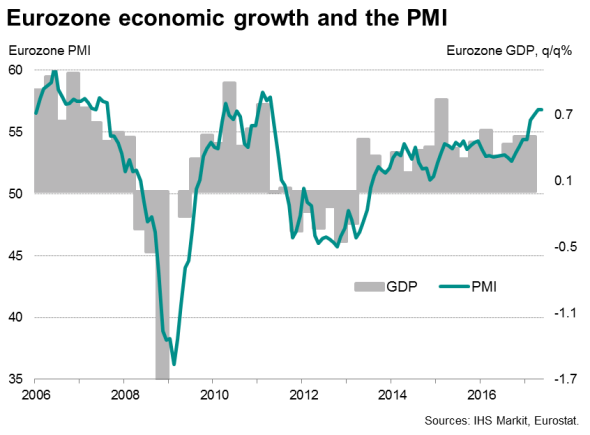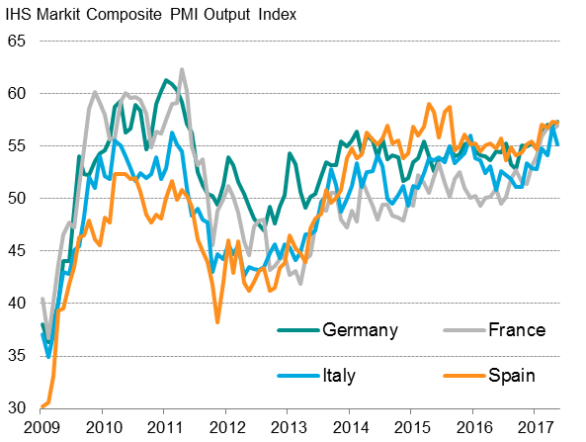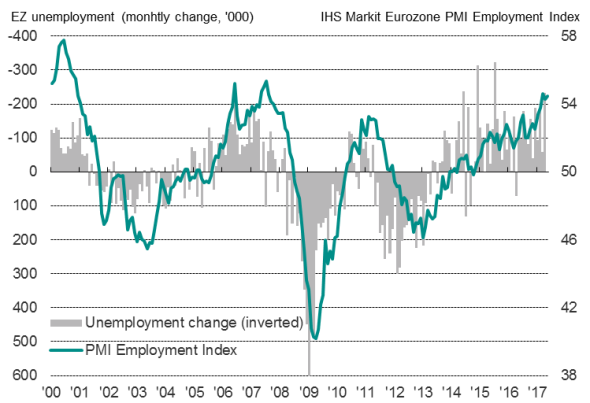Customer Logins
Obtain the data you need to make the most informed decisions by accessing our extensive portfolio of information, analytics, and expertise. Sign in to the product or service center of your choice.
Customer Logins
ECONOMICS COMMENTARY
Jun 05, 2017
Eurozone set for strong second quarter as PMI holds at six-year high
The final PMI readings add to mounting evidence that the eurozone is enjoying a strong second quarter, and possibly a better than previously anticipated 2017. The latest reading of 56.8, unchanged in May on the six-year high seen in April, is consistent with GDP rising at a 0.7% quarterly rate, according to historical comparisons of survey and official data.

Better than previously thought upturn
Encouragingly, both the hard data and the surveys are revealing a broad-based upturn. So far in the second quarter the PMI surveys are running at levels indicative of 0.7% GDP growth in France and Germany, with nearly 1% being signalled for Spain and 0.5% in Italy.
Strong growth in all big-four euro nations

The upbeat message of recent PMI data has surprised many analysts and raised some eyebrows, not least because official data have lagged behind the strength signalled by PMI data. However, official estimates do tend to lag behind during periods of rapid change, and recent revisions to first quarter GDP estimates are now bringing the official numbers more in line with the surveys.
First quarter economic growth in Italy has been revised up from 0.2% to 0.4%, and in France the growth rate has been re-estimated at 0.4% rather than an initial 0.3%. There's consequently a chance that first quarter GDP for the euro area as a whole could be revised higher from the current 0.5% estimate. At an average of 55.6 in the three months to March, PMI data signalled a GDP growth rate more like 0.6% than 0.5%.
Buoyant hiring
The surveys also brought good news on the labour market. The rate of job creation across the region as a whole rose to one of the highest seen over the past decade. Manufacturing employment growth reached a 20-year survey record.
While Germany saw the strongest employment growth of the 'big-four' euro members, solid gains were also seen in France, Italy and Spain.
The upturn in employment suggests the recovery is becoming more sustainable, as the improved labour market should feed through to higher consumer spending.
Eurozone labour market

With the weak euro helping to boost manufacturing - seven of the top eight performers in terms of export growth globally are all euro currency members according to the May PMI surveys - and domestic demand picking up, the outlook for the eurozone economy therefore seems to be tilting to the upside, meaning it's likely that we'll start to see many forecasters' expectations for 2017 growth revised higher.
Chris Williamson | Chief Business Economist, IHS Markit
Tel: +44 20 7260 2329
chris.williamson@ihsmarkit.com
{"items" : [
{"name":"share","enabled":true,"desc":"<strong>Share</strong>","mobdesc":"Share","options":[ {"name":"facebook","url":"https://www.facebook.com/sharer.php?u=http%3a%2f%2fwww.spglobal.com%2fmarketintelligence%2fen%2fmi%2fresearch-analysis%2f05062017-Economics-Eurozone-set-for-strong-second-quarter-as-PMI-holds-at-six-year-high.html","enabled":true},{"name":"twitter","url":"https://twitter.com/intent/tweet?url=http%3a%2f%2fwww.spglobal.com%2fmarketintelligence%2fen%2fmi%2fresearch-analysis%2f05062017-Economics-Eurozone-set-for-strong-second-quarter-as-PMI-holds-at-six-year-high.html&text=Eurozone+set+for+strong+second+quarter+as+PMI+holds+at+six-year+high","enabled":true},{"name":"linkedin","url":"https://www.linkedin.com/sharing/share-offsite/?url=http%3a%2f%2fwww.spglobal.com%2fmarketintelligence%2fen%2fmi%2fresearch-analysis%2f05062017-Economics-Eurozone-set-for-strong-second-quarter-as-PMI-holds-at-six-year-high.html","enabled":true},{"name":"email","url":"?subject=Eurozone set for strong second quarter as PMI holds at six-year high&body=http%3a%2f%2fwww.spglobal.com%2fmarketintelligence%2fen%2fmi%2fresearch-analysis%2f05062017-Economics-Eurozone-set-for-strong-second-quarter-as-PMI-holds-at-six-year-high.html","enabled":true},{"name":"whatsapp","url":"https://api.whatsapp.com/send?text=Eurozone+set+for+strong+second+quarter+as+PMI+holds+at+six-year+high http%3a%2f%2fwww.spglobal.com%2fmarketintelligence%2fen%2fmi%2fresearch-analysis%2f05062017-Economics-Eurozone-set-for-strong-second-quarter-as-PMI-holds-at-six-year-high.html","enabled":true}]}, {"name":"rtt","enabled":true,"mobdesc":"Top"}
]}




